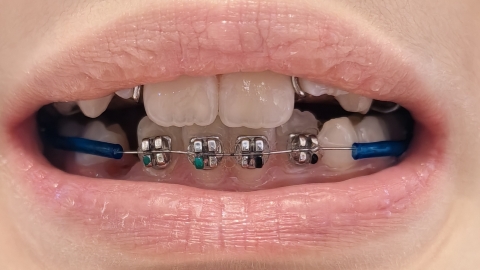Why do gaps appear between teeth after orthodontic treatment, and what should be done?
Generally speaking, gaps appearing between teeth after orthodontic treatment may be caused by tooth tilting or malalignment, excessive orthodontic force, failure to wear a retainer or insufficient wearing time after correction, dental caries or tooth decay, periodontal disease, and other factors. Treatments such as routine therapy, dental fillings, supragingival scaling, subgingival curettage, etc., can be conducted under a doctor's guidance. Detailed analysis is as follows:

1. Tooth Tilting or Malalignment
Teeth may naturally develop poorly or be misaligned. During orthodontic treatment, gaps may temporarily appear as teeth move. Continuing to wear the orthodontic appliance will gradually align the teeth, and the gaps will gradually disappear.
2. Excessive Orthodontic Force
During orthodontic treatment, improper use of force, such as excessive force, may cause teeth to move too quickly, resulting in gaps between teeth. It is recommended to visit a reputable dental hospital for an examination, allowing a professional dentist to adjust the magnitude of orthodontic force, ensuring teeth move slowly under appropriate pressure, thus avoiding the formation of gaps.
3. Failure to Wear a Retainer or Insufficient Wearing Time After Orthodontic Treatment
After completing orthodontic treatment, retainers must be worn to consolidate the treatment results. If retainers are not worn or are worn for insufficient time, teeth may gradually return to their original positions due to lack of constraint, creating gaps. It will be necessary to wear retainers again and follow the doctor's instructions regarding wearing duration. If the gaps are too large or cannot recover on their own, further orthodontic treatment may need to be considered.
4. Dental Caries or Tooth Decay
Poor oral hygiene during orthodontic treatment may lead to dental caries or tooth decay, which can subsequently cause gaps between teeth. Daily oral hygiene should be strengthened, along with regular dental checkups and cleaning. Fillings can also be performed under a doctor's guidance. The dentist will first use a dental drill to remove decayed tissue and prepare the cavity into a specific shape. Then, filling materials such as resin will be used to restore the tooth's shape and function. The general reference price for a filling is 100-500 yuan per tooth. Improvement is usually noticeable within 3-5 days after the procedure, although symptoms such as gingival redness and swelling or itching may occur.
5. Periodontal Disease
Periodontal disease is an inflammatory condition affecting the tissues surrounding the teeth, which may cause tooth loosening, thereby creating gaps during orthodontic treatment. Targeted periodontal treatments such as supragingival scaling and subgingival curettage should be performed to improve periodontal conditions and prevent the worsening of tooth gaps. At the same time, special attention should be paid to oral hygiene during orthodontic treatment to maintain oral cleanliness.
If gaps appear after orthodontic treatment, prompt medical examination is necessary to identify the cause and receive targeted treatment under a doctor's guidance. Additionally, special attention should be paid to oral hygiene and retainer wearing both during and after orthodontic treatment to ensure the stability and long-term effectiveness of the treatment results.




